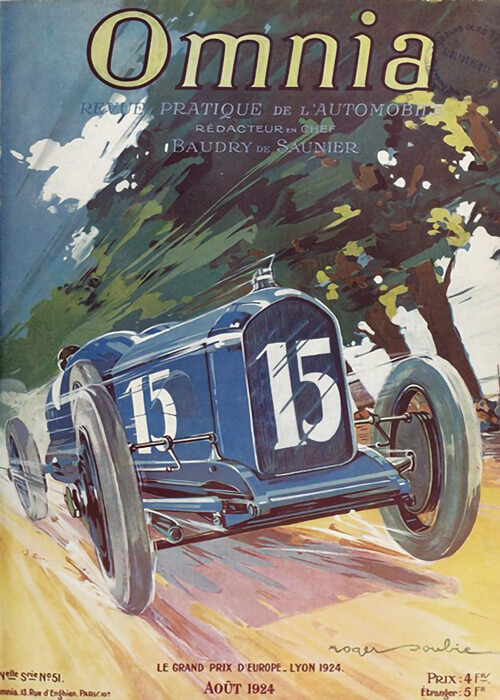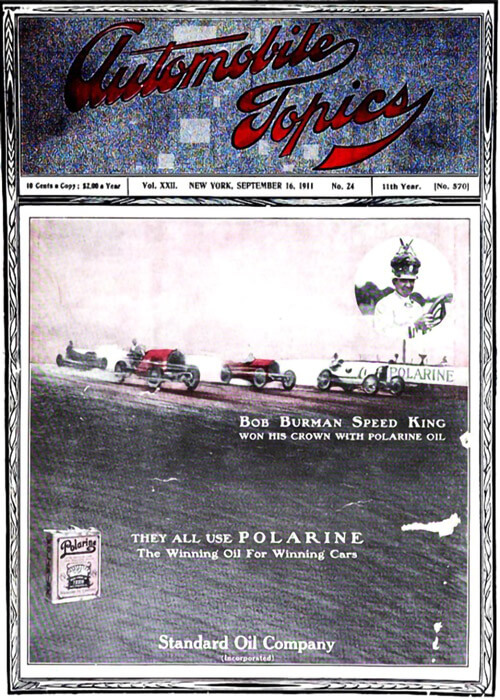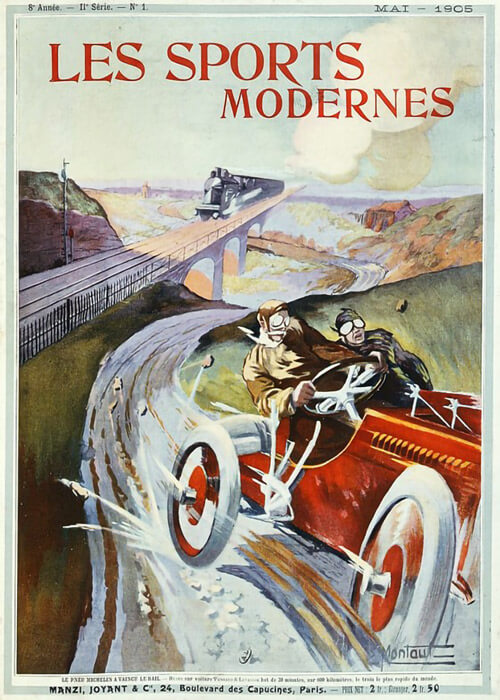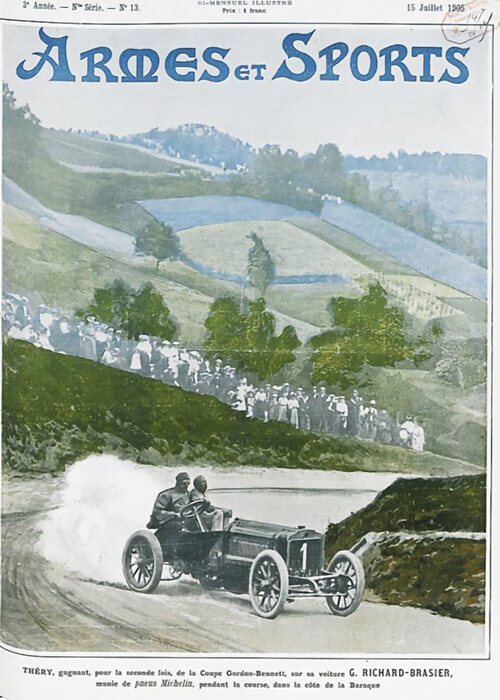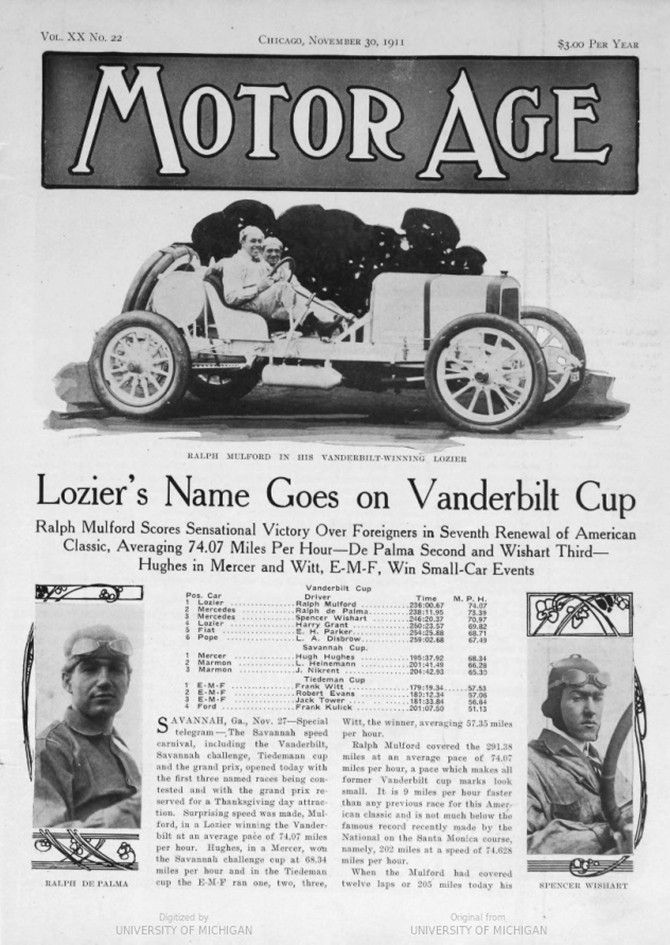
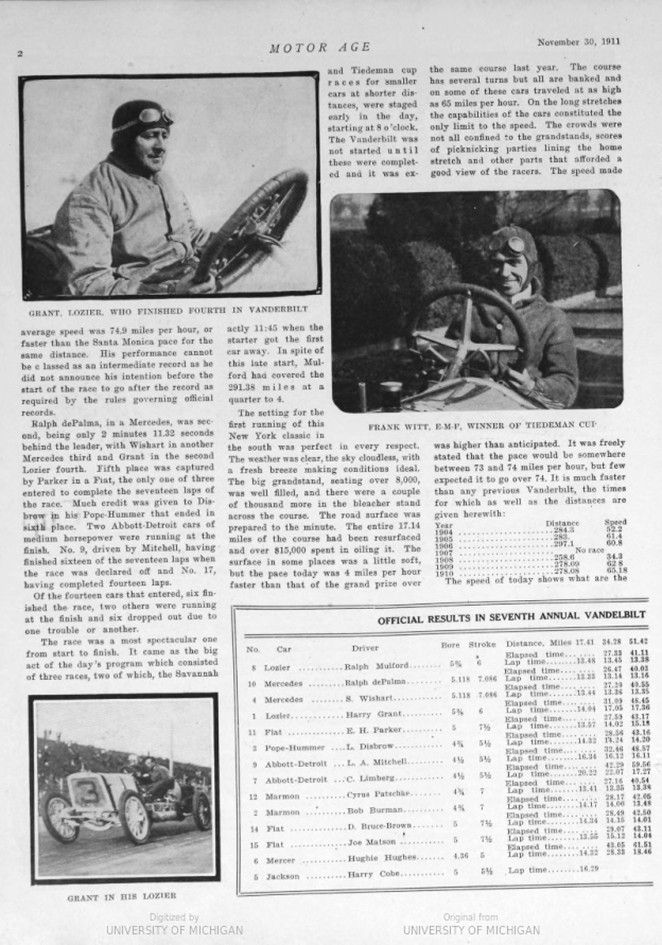
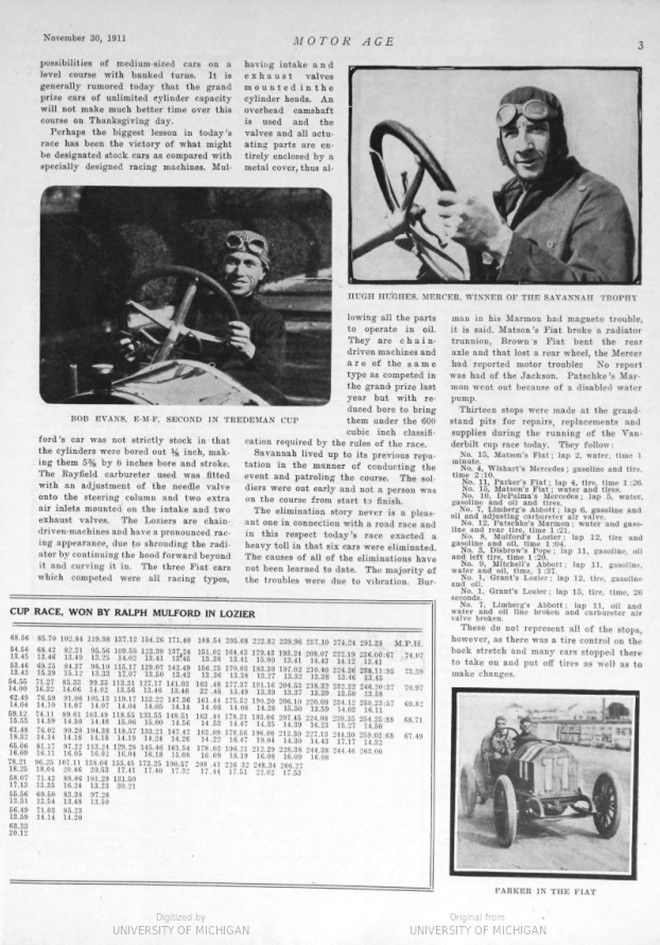
Text and pictures with courtesy of hathitrust.org hathitrust.org; compiled by motorracinghistory.com
MOTOR AGE VOL. XX, No. 22, NOVEMBER 30, 1911
Lozier’s Name Goes on Vanderbilt Cup
Ralph Mulford Scores Sensational Victory Over Foreigners in Seventh Renewal of American Classic, Averaging 74.07 Miles Per Hour
De Palma Second and Wishart Third – Hughes in Mercer and Witt, E-M-F, Win Small-Car Events
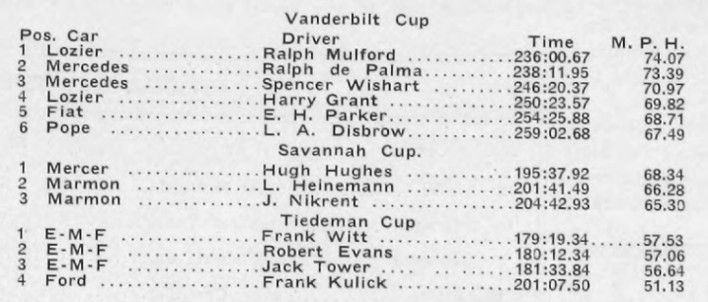
SAVANNAH, Ga., Nov. 27 – Special telegram – The Savannah speed carnival, including the Vanderbilt, Savannah challenge, Tiedemann cup and the grand prix, opened today with the first three named races being contested and with the grand prix reserved for a Thanksgiving Day attraction. Surprising speed was made, Mulford, in a Lozier winning the Vanderbilt at an average pace of 74.07 miles per hour. Hughes, in a Mercer, won the Savannah challenge cup at 68.34 miles per hour and in the Tiedeman cup the E-M-F ran one, two, three, Witt, the winner, averaging 57.35 miles per hour. Ralph Mulford covered the 291.38 miles at an average pace of 74.07 miles per hour, a pace which makes all former Vanderbilt cup marks look small. It is 9 miles per hour faster than any previous race for this American classic and is not much below the famous record recently made by the National on the Santa Monica course, namely, 202 miles at a speed of 74.628 miles per hour.
When Mulford had covered the twelve laps or 205 miles today his average speed was 74.9 miles per hour, or faster than the Santa Monica pace for the same distance. His performance cannot be classed as an intermediate record as he did not announce his intention before the start of the race to go after the record as required by the rules governing official records.
Ralph de Palma, in a Mercedes, was second, being only 2 minutes 11.32 seconds behind the leader, with Wishart in another Mercedes third and Grant in the second Lozier fourth. Fifth place was captured by Parker in a Fiat, the only one of three entered to complete the seventeen laps of the race. Much credit was given to Dis- brow in his Pope-Hummer that ended in sixth place. Two Abbott-Detroit cars of medium horsepower were running at the finish. No. 9, driven by Mitchell, having finished sixteen of the seventeen laps when the race was declared off and No. 17, having completed fourteen laps.
Of the fourteen cars that entered, six finished the race, two others were running at the finish and six dropped out due to one trouble or another.
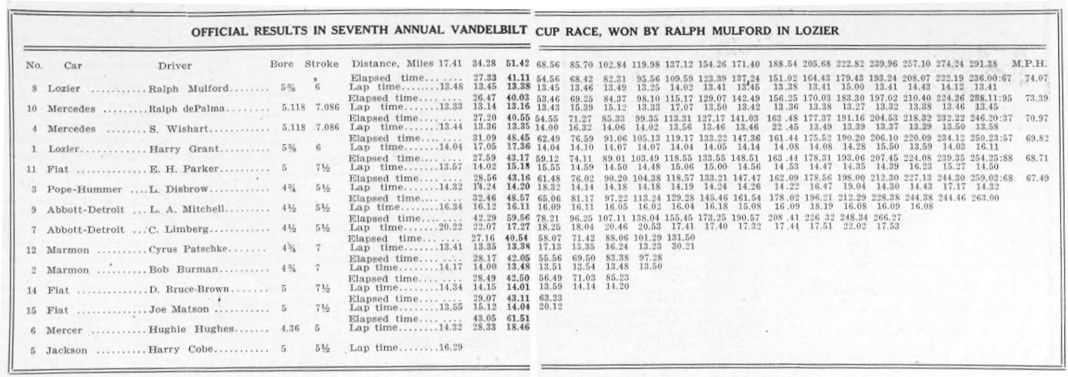
The race was a most spectacular one from start to finish. It came as the big act of the day’s program which consisted of three races, two of which, the Savannah and Tiedeman cup races for smaller cars at shorter distances, were staged early in the day, starting at 8 o’clock. The Vanderbilt was not started until these were completed and it was exactly 11:45 when the starter got the first car away. In spite of this late start, Mul- ford had covered the 291.38 miles at a quarter to 4.
The setting for the first running of this New York classic in the south was perfect in every respect. The weather was clear, the sky cloudless, with a fresh breeze making conditions ideal. The big grandstand, seating over 8,000, was well filled, and there were a couple of thousand more in the bleacher stand across the course. The road surface was prepared to the minute. The entire 17.14 miles of the course had been resurfaced and over $15,000 spent in oiling it. The surface in some places was a little soft, but the pace today was 4 miles per hour faster than that of the grand prize over the same course last year. The course has several turns, but all are banked and on some of these cars traveled at as high as 65 miles per hour. On the long stretches the capabilities of the cars constituted the only limit to the speed. The crowds were not all confined to the grandstands, scores of picnicking parties lining the home stretch and other parts that afforded a good view of the racers. The speed made was higher than anticipated. It was freely stated that the pace would be somewhere between 73 and 74 miles per hour, but few expected it to go over 74. It is much faster than any previous Vanderbilt, the times for which as well as the distances are given herewith:
Year Distance Speed
1904 284.3 52.2
1905 283. 61.4
1906 297.1 60.8
1907 No race
1908 258.6 34.3
1909 278.09 62.8
1910 278.08 65.18
The speed of today shows what are the possibilities of medium-sized cars on a level course with banked turns. It is generally rumored today that the grand prize cars of unlimited cylinder capacity will not make much better time over this course on Thanksgiving Day.
Perhaps the biggest lesson in today’s race has been the victory of what might be designated stock cars as compared with specially designed racing machines. Mulford’s car was not strictly stock in that the cylinders were bored out 1½ inch, making them 5 3/8 by 6 inches bore and stroke. The Rayfield carbureter used was fitted with an adjustment of the needle valve onto the steering column and two extra air inlets mounted on the intake and two exhaust valves. The Loziers are chain-driven-machines and have a pronounced racing appearance, due to shrouding the radiator by continuing the hood forward beyond it and curving it in. The three Fiat cars which competed were all racing types, having intake and exhaust valves mounted in the cylinder heads. An overhead camshaft is used and the valves and all actuating parts are entirely enclosed by a metal cover, thus allowing all the parts to operate in oil. They are chain- driven machines and are of the same type as competed in the grand prize last year but with reduced bore to bring them under the 600 cubic inch classification required by the rules of the race.
Savannah lived up to its previous reputation in the manner of conducting the event and patrolling the course. The soldiers were out early and not a person was on the course from start to finish.
The elimination story never is a pleasant one in connection with a road race and in this respect today’s race exacted a heavy toll in that six cars were eliminated. The causes of all of the eliminations have not been learned to date. The majority of the troubles were due to vibration. Burman in his Marmon had magneto trouble, it is said. Matson’s Fiat broke a radiator trunnion, Brown’s Fiat bent the rear axle and that lost a rear wheel, the Mercer had reported motor troubles No report was had of the Jackson. Patschke’s Marmon went out because of a disabled water pump.
Thirteen stops were made at the grandstand pits for repairs, replacements and supplies during the running of the Vanderbilt cup race today. They follow:
No. 15, Matson’s Fiat; lap 2, water, time 1 minute.
No. 4, Wishart’s Mercedes; gasoline and tire, time 2:10.
No. 11, Parker’s Fiat; lap 4, tire, time 1:26.
No. 15, Matson’s Fiat; water and tires.
No. 10, DePalma’s Mercedes; lap 5, water, gasoline and oil and tires.
No. 7, Limberg’s Abbott; lap 6, gasoline and oil and adjusting carbureter air valve.
No. 12, Patschke’s Marmon; water and gasoline and rear tire, time 1:21.
No. 8, Mulford’s Lozier; lap 12, tire and gasoline and oil, time 1:04.
No. 3, Disbrow’s Pope; lap 11, gasoline, oil and left tire, time 1:20.
No. 9, Mitchell’s Abbott; lap 11, gasoline, water and oil, time, 1:37.
No. 1, Grant’s Lozier; lap 12, tire, gasoline and oil.
No. 1, Grant’s Lozier; lap 15, tire, time, 26 seconds.
No. 7, Limberg’s Abbott; lap 11, oil and water and oil line broken and carbureter air valve broken.
These do not represent all of the stops, however, as there was a tire control on the back stretch and many cars stopped there to take on and put off tires as well as to make changes.
Photo captions.
Page 1. RALPH MULFORD IN HIS VANDERBILT-WINNING LOZIER
RALPH DE PALMA – SPENCER WISHART
Page 2. GRANT, LOZIER, WHO FINISHED FOURTH IN VANDERBILT – FRANK WITT, E-M-F, WINNER OF TIEDEMAN CUP – GRANT IN HIS LOZIER
OFFICIAL RESULTS IN SEVENTH ANNUAL VANDELBILT CUP RACE, WON BY RALPH MULFORD IN LOZIER
Page 3. BOB EVANS, E-M-F, SECOND IN TREDEMAN CUP – HUGH HƯGHES, MERCER, WINNER OF THE SAVANNAH TROPHY – PARKER IN THE FIAT

